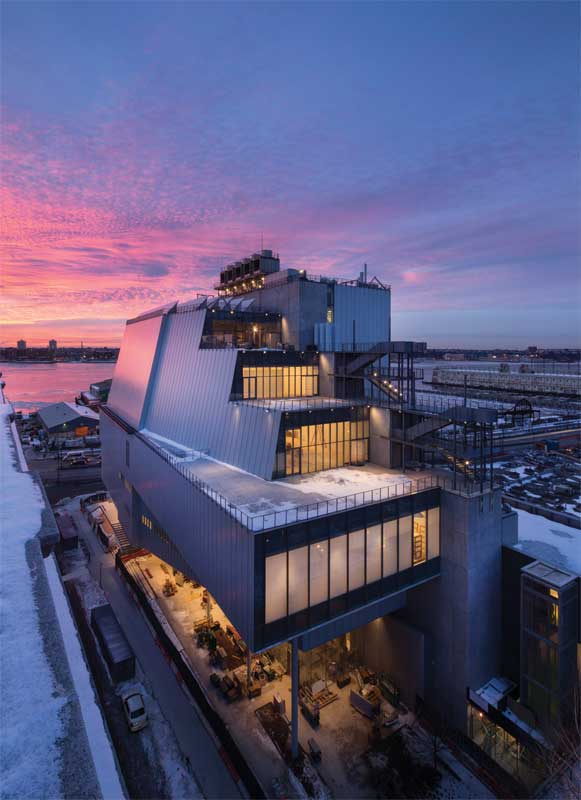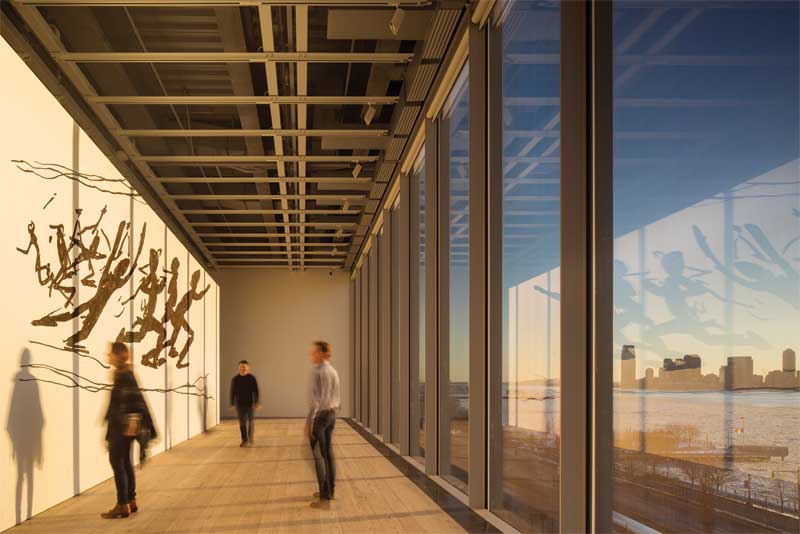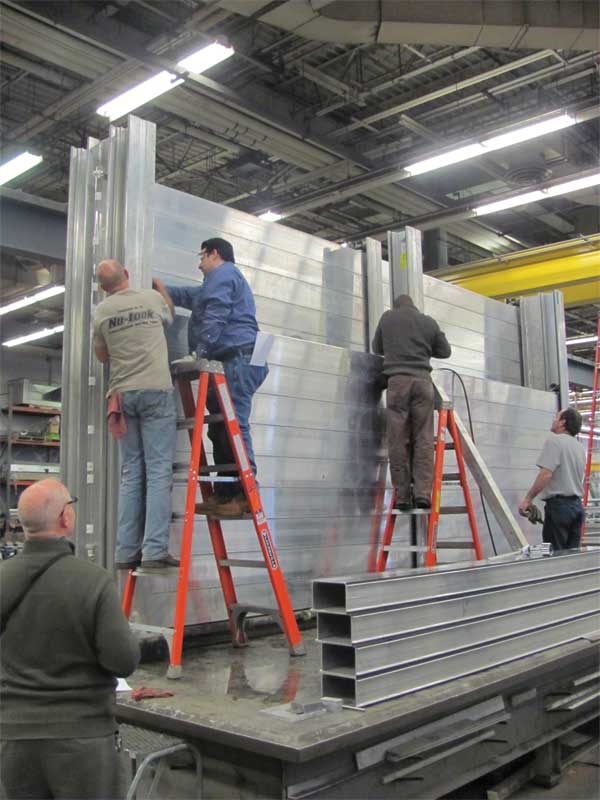
by Scott Newman, FAIA
As architects and engineers consider design responses to climate change, Building owners’ priorities and cost will drive specific strategies and scope to mitigate the risks of extreme weather. In all cases, the safety and protection of occupants is paramount. Beyond this obligation, however, the level of protection
of the capital investment, and the recovery response time are variable considerations. For museums and other collecting institutions, safeguarding the exhibits and collections is central to their mission. Design professionals undertaking these projects must now consider resilient design as a key requirement.
The Resilient Design Institute defines resilient design as “the intentional design of buildings, landscapes, communities, and regions in response to vulnerabilities to disaster and disruption of normal life.”
The location of the new Whitney Museum of American Art is particularly sensitive to water-level rise and storm surge. The 20,438-m2 (220,000-sf) museum in New York City is adjacent to the Hudson River. The building’s design anticipates the effects of climate change and protects the museum’s staff and collections from severe flood storms through both planning and resilient design features.
The new building opened in the spring of 2015, and was immediately recognized for the innovative way the architecture responds to its unique setting between the Hudson River and the High Line Park. The eight-story museum has both visual transparency and outdoor terraced galleries making connections among visitors, exhibits, and the surrounding city and riverfront. While the design treats the river as an asset central to the visitor experience, the design team also had to respond to the risks posed by its proximity.
The architects, Renzo Piano Building Workshop in collaboration with Cooper Robertson, initially designed the building in accordance with standards set by the American Society of Civil Engineers (ASCE) for structures in flood hazard areas to meet or exceed requirements of the National Flood Insurance Program (NFIP), which is administered by the U.S. Federal Emergency Management Agency (FEMA). These standards are derived from ASCE 24, Flood Resistant Design and Construction, and include anchoring of the pile foundation and building structure to “resist flotation, collapse, and lateral movement due to the effects of wind and flood loads acting simultaneously on all building components, and other load requirements” of the New York City Building Code.

The original design for the building was planned to resist and mitigate the potential impacts of severe climatic events. The ground floor was elevated by an additional 0.3 m (1 ft) above the levels recommended by FEMA before superstorm Sandy. No significant gallery spaces or art storage was planned to be located below level five. When Hurricane Sandy hit New York City in October 2012, the museum was well under construction and, while not yet enclosed, some basic elements of the building’s design were already in place to protect the structure in case of flooding.
The timing of the storm enabled the design team to observe how the building would perform in a serious flood event. The structure withstood the hurricane well, but a historic storm surge brought unprecedented high water levels, with more than 22.7 million L (6 million gal) of river water filling the building’s 9-m (30-ft) deep open basement. The devastating effects of the storm on New York’s infrastructure transformed flood-mitigation design, and the timing of the Whitney Museum project placed the design team at the forefront of resilient building design.

Photos courtesy Cooper Robertson
Following the storm, FEMA revised its flood zone maps to recommend an additional 1.4 m (4.5 ft) of elevation for buildings in the Whitney flood zone. As is the case with all federal flood standards, this new FEMA elevation did not account for sea level rise. To define a more realistic storm surge level and mitigation design criteria, the Whitney team conducted an international search for an experienced advisor. They selected two groups well versed in protecting urban environments from floods: WTM Engineers of Hamburg, Germany, and their partner, the Franzius Institute for Hydraulic, Estuarine, and Coastal Engineering of the Leibniz University in Hanover.
The analysis was particularly complex, since the design criteria had to account for the combined actions of extreme storm surge heights, locally wind-generated waves, and the Hudson River hydrology, which is tidal. The Franzius Institute was uniquely qualified to undertake this study with both large and shallow wave basins for actual physical modeling of coastal hydrodynamics, wave actions, and impacts on flood defense systems.
The Franzius Institute undertook an extensive study of New York Harbor and its environmental history, and advised the building should be protected to a higher elevation of 5 m (16.5 ft), anticipating sea level rise. Following the recommendation, the project team worked with WTM Engineers to design modifications, both permanent and deployable, to Whitney’s structure as protection against future storms. These improvements were not required legally since Whitney’s building permit remained in force according to the codes in place at the time of filing, and updates to the ASCE standards or FEMA mapping would not apply to the project retroactively. However, by using project-specific, proprietary, and context-specific design criteria, the Whiney team was able to develop innovative solutions exceeding the broader code and standard changes being considered, and ultimately enacted.





This is such bad news for the people working at the museum and for them too who use to visit the museum once a week. Whenever disasters like storms, hurricane or say flood occurs, it totally disturbs many lives as it can cause many damages to a human being as well as to the household things. I hope the museum owner must have already done with an agreement of such disasters with an insurance company so that at least they can get a coverage amount of damage from the insurance company. They can even talk with professional public adjusters like Alliance public adjusters ( alliancepublicadjusters.com ) for helpful hints.